2001 CHRYSLER VOYAGER engine
[x] Cancel search: enginePage 1218 of 4284
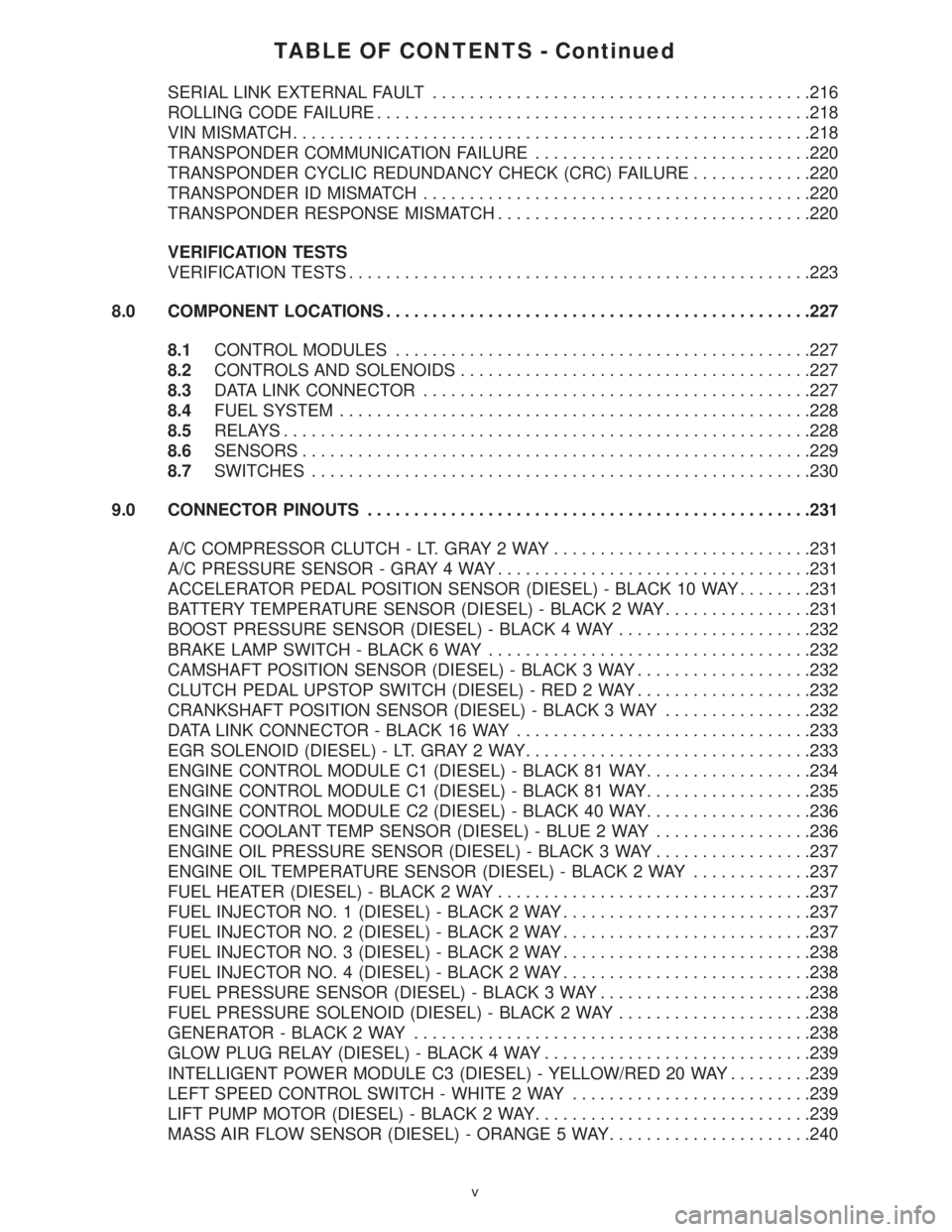
TABLE OF CONTENTS - Continued
SERIAL LINK EXTERNAL FAULT.........................................216
ROLLING CODE FAILURE...............................................218
VIN MISMATCH........................................................218
TRANSPONDER COMMUNICATION FAILURE..............................220
TRANSPONDER CYCLIC REDUNDANCY CHECK (CRC) FAILURE.............220
TRANSPONDER ID MISMATCH..........................................220
TRANSPONDER RESPONSE MISMATCH..................................220
VERIFICATION TESTS
VERIFICATION TESTS..................................................223
8.0 COMPONENT LOCATIONS..............................................227
8.1CONTROL MODULES.............................................227
8.2CONTROLS AND SOLENOIDS......................................227
8.3DATA LINK CONNECTOR..........................................227
8.4FUEL SYSTEM...................................................228
8.5RELAYS.........................................................228
8.6SENSORS.......................................................229
8.7SWITCHES......................................................230
9.0 CONNECTOR PINOUTS................................................231
A/C COMPRESSOR CLUTCH - LT. GRAY 2 WAY............................231
A/C PRESSURE SENSOR - GRAY 4 WAY..................................231
ACCELERATOR PEDAL POSITION SENSOR (DIESEL) - BLACK 10 WAY........231
BATTERY TEMPERATURE SENSOR (DIESEL) - BLACK 2 WAY................231
BOOST PRESSURE SENSOR (DIESEL) - BLACK 4 WAY.....................232
BRAKE LAMP SWITCH - BLACK 6 WAY...................................232
CAMSHAFT POSITION SENSOR (DIESEL) - BLACK 3 WAY...................232
CLUTCH PEDAL UPSTOP SWITCH (DIESEL) - RED 2 WAY...................232
CRANKSHAFT POSITION SENSOR (DIESEL) - BLACK 3 WAY................232
DATA LINK CONNECTOR - BLACK 16 WAY................................233
EGR SOLENOID (DIESEL) - LT. GRAY 2 WAY...............................233
ENGINE CONTROL MODULE C1 (DIESEL) - BLACK 81 WAY..................234
ENGINE CONTROL MODULE C1 (DIESEL) - BLACK 81 WAY..................235
ENGINE CONTROL MODULE C2 (DIESEL) - BLACK 40 WAY..................236
ENGINE COOLANT TEMP SENSOR (DIESEL) - BLUE 2 WAY.................236
ENGINE OIL PRESSURE SENSOR (DIESEL) - BLACK 3 WAY.................237
ENGINE OIL TEMPERATURE SENSOR (DIESEL) - BLACK 2 WAY.............237
FUEL HEATER (DIESEL) - BLACK 2 WAY..................................237
FUEL INJECTOR NO. 1 (DIESEL) - BLACK 2 WAY...........................237
FUEL INJECTOR NO. 2 (DIESEL) - BLACK 2 WAY...........................237
FUEL INJECTOR NO. 3 (DIESEL) - BLACK 2 WAY...........................238
FUEL INJECTOR NO. 4 (DIESEL) - BLACK 2 WAY...........................238
FUEL PRESSURE SENSOR (DIESEL) - BLACK 3 WAY.......................238
FUEL PRESSURE SOLENOID (DIESEL) - BLACK 2 WAY.....................238
GENERATOR - BLACK 2 WAY...........................................238
GLOW PLUG RELAY (DIESEL) - BLACK 4 WAY.............................239
INTELLIGENT POWER MODULE C3 (DIESEL) - YELLOW/RED 20 WAY.........239
LEFT SPEED CONTROL SWITCH - WHITE 2 WAY..........................239
LIFT PUMP MOTOR (DIESEL) - BLACK 2 WAY..............................239
MASS AIR FLOW SENSOR (DIESEL) - ORANGE 5 WAY......................240
v
Page 1220 of 4284
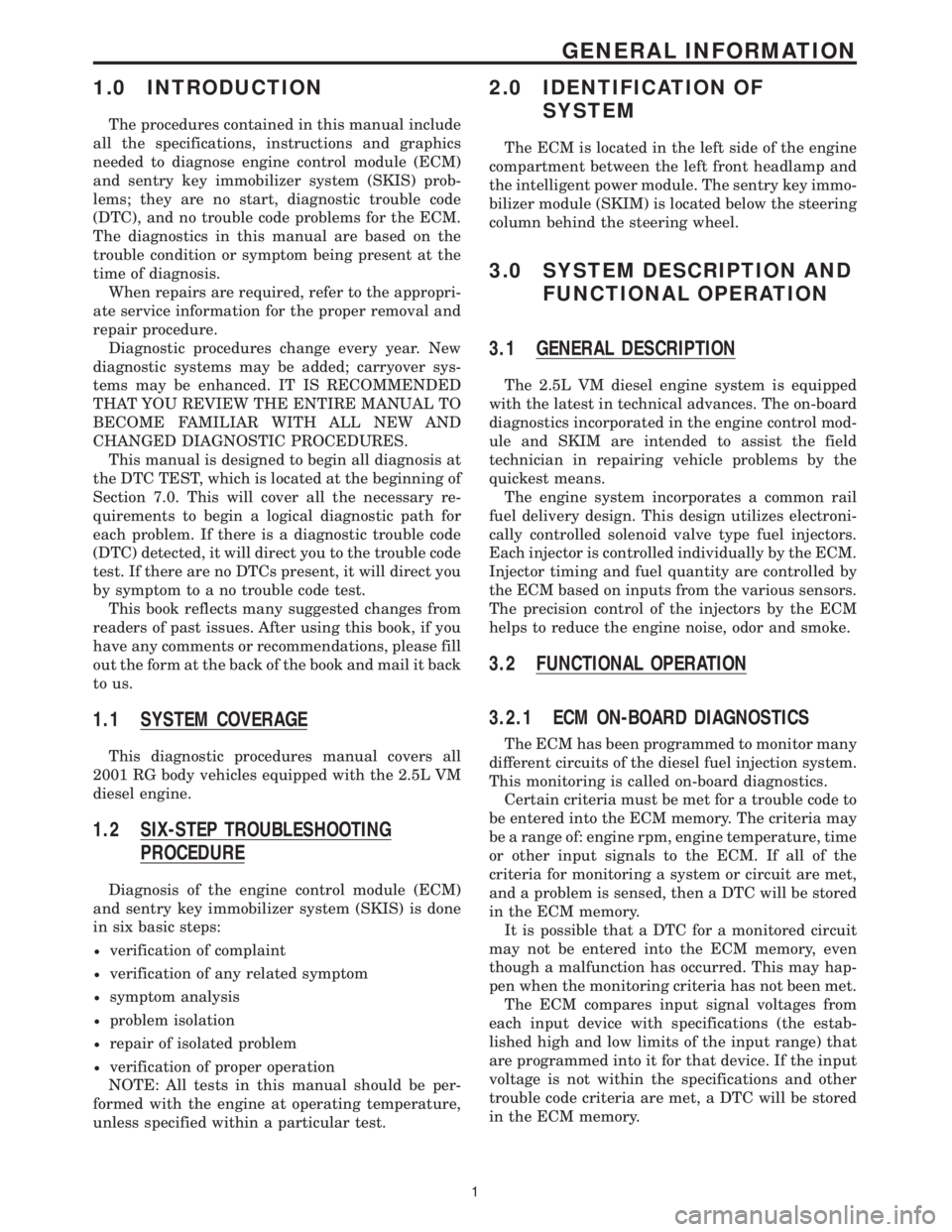
1.0 INTRODUCTION
The procedures contained in this manual include
all the specifications, instructions and graphics
needed to diagnose engine control module (ECM)
and sentry key immobilizer system (SKIS) prob-
lems; they are no start, diagnostic trouble code
(DTC), and no trouble code problems for the ECM.
The diagnostics in this manual are based on the
trouble condition or symptom being present at the
time of diagnosis.
When repairs are required, refer to the appropri-
ate service information for the proper removal and
repair procedure.
Diagnostic procedures change every year. New
diagnostic systems may be added; carryover sys-
tems may be enhanced. IT IS RECOMMENDED
THAT YOU REVIEW THE ENTIRE MANUAL TO
BECOME FAMILIAR WITH ALL NEW AND
CHANGED DIAGNOSTIC PROCEDURES.
This manual is designed to begin all diagnosis at
the DTC TEST, which is located at the beginning of
Section 7.0. This will cover all the necessary re-
quirements to begin a logical diagnostic path for
each problem. If there is a diagnostic trouble code
(DTC) detected, it will direct you to the trouble code
test. If there are no DTCs present, it will direct you
by symptom to a no trouble code test.
This book reflects many suggested changes from
readers of past issues. After using this book, if you
have any comments or recommendations, please fill
out the form at the back of the book and mail it back
to us.
1.1 SYSTEM COVERAGE
This diagnostic procedures manual covers all
2001 RG body vehicles equipped with the 2.5L VM
diesel engine.
1.2 SIX-STEP TROUBLESHOOTING
PROCEDURE
Diagnosis of the engine control module (ECM)
and sentry key immobilizer system (SKIS) is done
in six basic steps:
²verification of complaint
²verification of any related symptom
²symptom analysis
²problem isolation
²repair of isolated problem
²verification of proper operation
NOTE: All tests in this manual should be per-
formed with the engine at operating temperature,
unless specified within a particular test.
2.0 IDENTIFICATION OF
SYSTEM
The ECM is located in the left side of the engine
compartment between the left front headlamp and
the intelligent power module. The sentry key immo-
bilizer module (SKIM) is located below the steering
column behind the steering wheel.
3.0 SYSTEM DESCRIPTION AND
FUNCTIONAL OPERATION
3.1 GENERAL DESCRIPTION
The 2.5L VM diesel engine system is equipped
with the latest in technical advances. The on-board
diagnostics incorporated in the engine control mod-
ule and SKIM are intended to assist the field
technician in repairing vehicle problems by the
quickest means.
The engine system incorporates a common rail
fuel delivery design. This design utilizes electroni-
cally controlled solenoid valve type fuel injectors.
Each injector is controlled individually by the ECM.
Injector timing and fuel quantity are controlled by
the ECM based on inputs from the various sensors.
The precision control of the injectors by the ECM
helps to reduce the engine noise, odor and smoke.
3.2 FUNCTIONAL OPERATION
3.2.1 ECM ON-BOARD DIAGNOSTICS
The ECM has been programmed to monitor many
different circuits of the diesel fuel injection system.
This monitoring is called on-board diagnostics.
Certain criteria must be met for a trouble code to
be entered into the ECM memory. The criteria may
be a range of: engine rpm, engine temperature, time
or other input signals to the ECM. If all of the
criteria for monitoring a system or circuit are met,
and a problem is sensed, then a DTC will be stored
in the ECM memory.
It is possible that a DTC for a monitored circuit
may not be entered into the ECM memory, even
though a malfunction has occurred. This may hap-
pen when the monitoring criteria has not been met.
The ECM compares input signal voltages from
each input device with specifications (the estab-
lished high and low limits of the input range) that
are programmed into it for that device. If the input
voltage is not within the specifications and other
trouble code criteria are met, a DTC will be stored
in the ECM memory.
1
GENERAL INFORMATION
Page 1221 of 4284
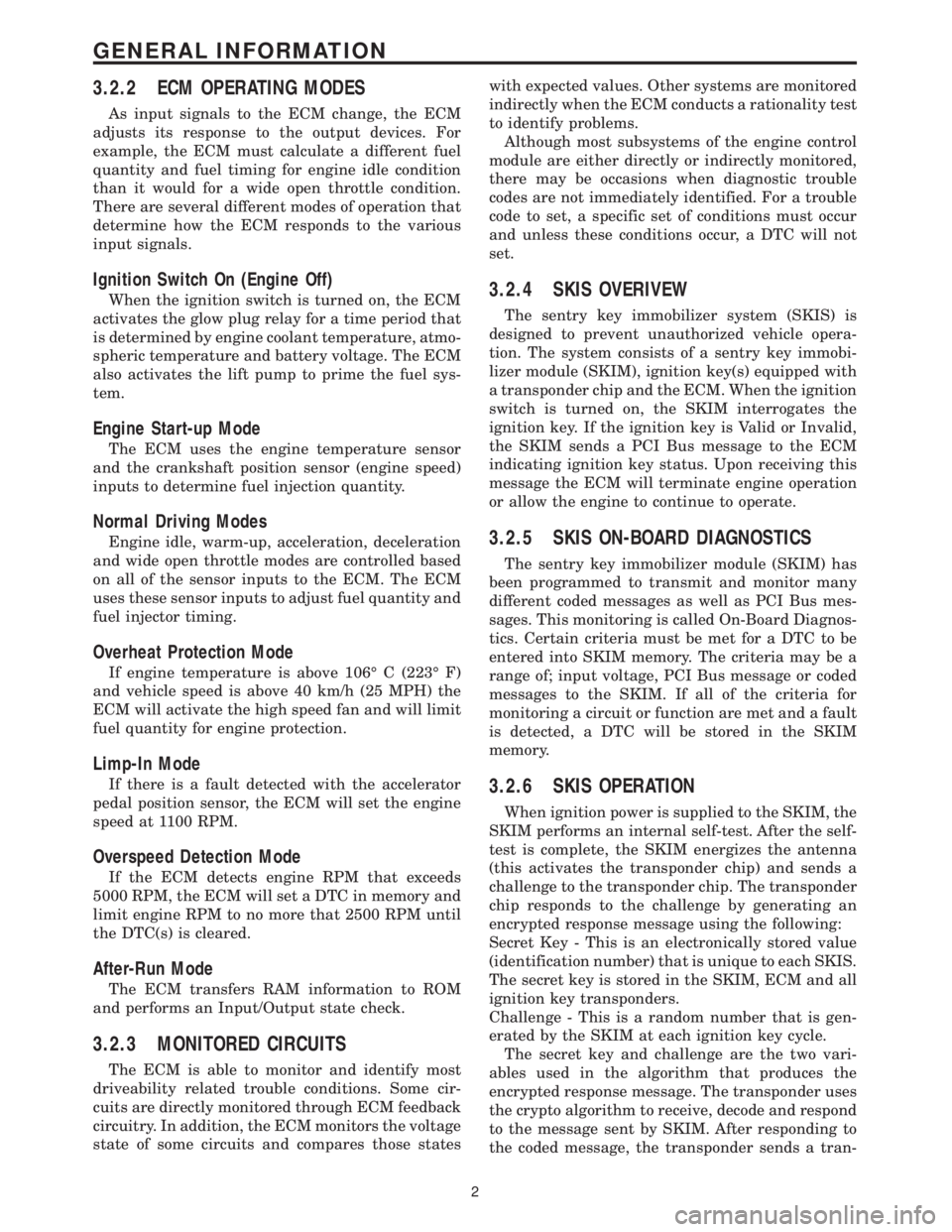
3.2.2 ECM OPERATING MODES
As input signals to the ECM change, the ECM
adjusts its response to the output devices. For
example, the ECM must calculate a different fuel
quantity and fuel timing for engine idle condition
than it would for a wide open throttle condition.
There are several different modes of operation that
determine how the ECM responds to the various
input signals.
Ignition Switch On (Engine Off)
When the ignition switch is turned on, the ECM
activates the glow plug relay for a time period that
is determined by engine coolant temperature, atmo-
spheric temperature and battery voltage. The ECM
also activates the lift pump to prime the fuel sys-
tem.
Engine Start-up Mode
The ECM uses the engine temperature sensor
and the crankshaft position sensor (engine speed)
inputs to determine fuel injection quantity.
Normal Driving Modes
Engine idle, warm-up, acceleration, deceleration
and wide open throttle modes are controlled based
on all of the sensor inputs to the ECM. The ECM
uses these sensor inputs to adjust fuel quantity and
fuel injector timing.
Overheat Protection Mode
If engine temperature is above 106É C (223É F)
and vehicle speed is above 40 km/h (25 MPH) the
ECM will activate the high speed fan and will limit
fuel quantity for engine protection.
Limp-In Mode
If there is a fault detected with the accelerator
pedal position sensor, the ECM will set the engine
speed at 1100 RPM.
Overspeed Detection Mode
If the ECM detects engine RPM that exceeds
5000 RPM, the ECM will set a DTC in memory and
limit engine RPM to no more that 2500 RPM until
the DTC(s) is cleared.
After-Run Mode
The ECM transfers RAM information to ROM
and performs an Input/Output state check.
3.2.3 MONITORED CIRCUITS
The ECM is able to monitor and identify most
driveability related trouble conditions. Some cir-
cuits are directly monitored through ECM feedback
circuitry. In addition, the ECM monitors the voltage
state of some circuits and compares those stateswith expected values. Other systems are monitored
indirectly when the ECM conducts a rationality test
to identify problems.
Although most subsystems of the engine control
module are either directly or indirectly monitored,
there may be occasions when diagnostic trouble
codes are not immediately identified. For a trouble
code to set, a specific set of conditions must occur
and unless these conditions occur, a DTC will not
set.
3.2.4 SKIS OVERIVEW
The sentry key immobilizer system (SKIS) is
designed to prevent unauthorized vehicle opera-
tion. The system consists of a sentry key immobi-
lizer module (SKIM), ignition key(s) equipped with
a transponder chip and the ECM. When the ignition
switch is turned on, the SKIM interrogates the
ignition key. If the ignition key is Valid or Invalid,
the SKIM sends a PCI Bus message to the ECM
indicating ignition key status. Upon receiving this
message the ECM will terminate engine operation
or allow the engine to continue to operate.
3.2.5 SKIS ON-BOARD DIAGNOSTICS
The sentry key immobilizer module (SKIM) has
been programmed to transmit and monitor many
different coded messages as well as PCI Bus mes-
sages. This monitoring is called On-Board Diagnos-
tics. Certain criteria must be met for a DTC to be
entered into SKIM memory. The criteria may be a
range of; input voltage, PCI Bus message or coded
messages to the SKIM. If all of the criteria for
monitoring a circuit or function are met and a fault
is detected, a DTC will be stored in the SKIM
memory.
3.2.6 SKIS OPERATION
When ignition power is supplied to the SKIM, the
SKIM performs an internal self-test. After the self-
test is complete, the SKIM energizes the antenna
(this activates the transponder chip) and sends a
challenge to the transponder chip. The transponder
chip responds to the challenge by generating an
encrypted response message using the following:
Secret Key - This is an electronically stored value
(identification number) that is unique to each SKIS.
The secret key is stored in the SKIM, ECM and all
ignition key transponders.
Challenge - This is a random number that is gen-
erated by the SKIM at each ignition key cycle.
The secret key and challenge are the two vari-
ables used in the algorithm that produces the
encrypted response message. The transponder uses
the crypto algorithm to receive, decode and respond
to the message sent by SKIM. After responding to
the coded message, the transponder sends a tran-
2
GENERAL INFORMATION
Page 1222 of 4284
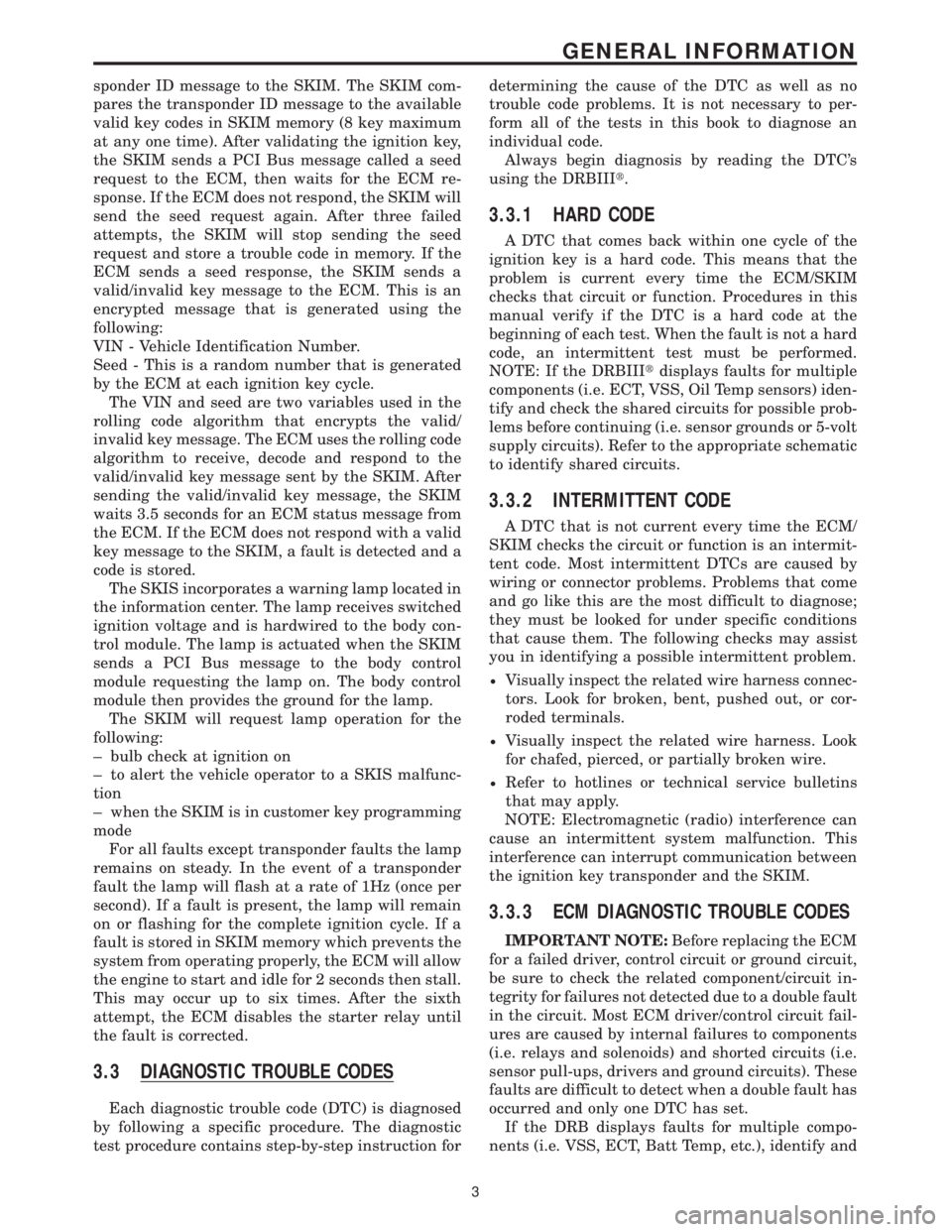
sponder ID message to the SKIM. The SKIM com-
pares the transponder ID message to the available
valid key codes in SKIM memory (8 key maximum
at any one time). After validating the ignition key,
the SKIM sends a PCI Bus message called a seed
request to the ECM, then waits for the ECM re-
sponse. If the ECM does not respond, the SKIM will
send the seed request again. After three failed
attempts, the SKIM will stop sending the seed
request and store a trouble code in memory. If the
ECM sends a seed response, the SKIM sends a
valid/invalid key message to the ECM. This is an
encrypted message that is generated using the
following:
VIN - Vehicle Identification Number.
Seed - This is a random number that is generated
by the ECM at each ignition key cycle.
The VIN and seed are two variables used in the
rolling code algorithm that encrypts the valid/
invalid key message. The ECM uses the rolling code
algorithm to receive, decode and respond to the
valid/invalid key message sent by the SKIM. After
sending the valid/invalid key message, the SKIM
waits 3.5 seconds for an ECM status message from
the ECM. If the ECM does not respond with a valid
key message to the SKIM, a fault is detected and a
code is stored.
The SKIS incorporates a warning lamp located in
the information center. The lamp receives switched
ignition voltage and is hardwired to the body con-
trol module. The lamp is actuated when the SKIM
sends a PCI Bus message to the body control
module requesting the lamp on. The body control
module then provides the ground for the lamp.
The SKIM will request lamp operation for the
following:
± bulb check at ignition on
± to alert the vehicle operator to a SKIS malfunc-
tion
± when the SKIM is in customer key programming
mode
For all faults except transponder faults the lamp
remains on steady. In the event of a transponder
fault the lamp will flash at a rate of 1Hz (once per
second). If a fault is present, the lamp will remain
on or flashing for the complete ignition cycle. If a
fault is stored in SKIM memory which prevents the
system from operating properly, the ECM will allow
the engine to start and idle for 2 seconds then stall.
This may occur up to six times. After the sixth
attempt, the ECM disables the starter relay until
the fault is corrected.
3.3 DIAGNOSTIC TROUBLE CODES
Each diagnostic trouble code (DTC) is diagnosed
by following a specific procedure. The diagnostic
test procedure contains step-by-step instruction fordetermining the cause of the DTC as well as no
trouble code problems. It is not necessary to per-
form all of the tests in this book to diagnose an
individual code.
Always begin diagnosis by reading the DTC's
using the DRBIIIt.
3.3.1 HARD CODE
A DTC that comes back within one cycle of the
ignition key is a hard code. This means that the
problem is current every time the ECM/SKIM
checks that circuit or function. Procedures in this
manual verify if the DTC is a hard code at the
beginning of each test. When the fault is not a hard
code, an intermittent test must be performed.
NOTE: If the DRBIIItdisplays faults for multiple
components (i.e. ECT, VSS, Oil Temp sensors) iden-
tify and check the shared circuits for possible prob-
lems before continuing (i.e. sensor grounds or 5-volt
supply circuits). Refer to the appropriate schematic
to identify shared circuits.
3.3.2 INTERMITTENT CODE
A DTC that is not current every time the ECM/
SKIM checks the circuit or function is an intermit-
tent code. Most intermittent DTCs are caused by
wiring or connector problems. Problems that come
and go like this are the most difficult to diagnose;
they must be looked for under specific conditions
that cause them. The following checks may assist
you in identifying a possible intermittent problem.
²Visually inspect the related wire harness connec-
tors. Look for broken, bent, pushed out, or cor-
roded terminals.
²Visually inspect the related wire harness. Look
for chafed, pierced, or partially broken wire.
²Refer to hotlines or technical service bulletins
that may apply.
NOTE: Electromagnetic (radio) interference can
cause an intermittent system malfunction. This
interference can interrupt communication between
the ignition key transponder and the SKIM.
3.3.3 ECM DIAGNOSTIC TROUBLE CODES
IMPORTANT NOTE:Before replacing the ECM
for a failed driver, control circuit or ground circuit,
be sure to check the related component/circuit in-
tegrity for failures not detected due to a double fault
in the circuit. Most ECM driver/control circuit fail-
ures are caused by internal failures to components
(i.e. relays and solenoids) and shorted circuits (i.e.
sensor pull-ups, drivers and ground circuits). These
faults are difficult to detect when a double fault has
occurred and only one DTC has set.
If the DRB displays faults for multiple compo-
nents (i.e. VSS, ECT, Batt Temp, etc.), identify and
3
GENERAL INFORMATION
Page 1223 of 4284
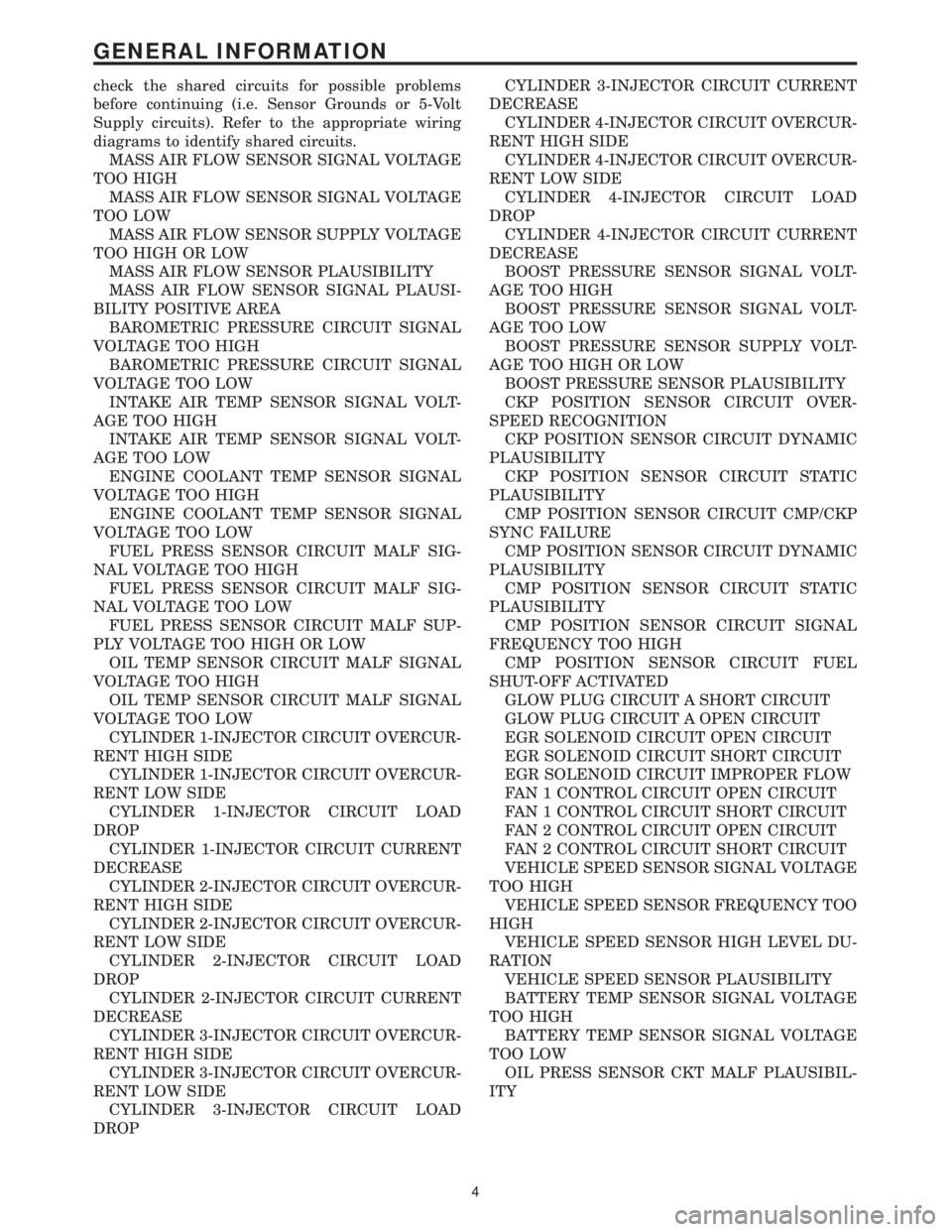
check the shared circuits for possible problems
before continuing (i.e. Sensor Grounds or 5-Volt
Supply circuits). Refer to the appropriate wiring
diagrams to identify shared circuits.
MASS AIR FLOW SENSOR SIGNAL VOLTAGE
TOO HIGH
MASS AIR FLOW SENSOR SIGNAL VOLTAGE
TOO LOW
MASS AIR FLOW SENSOR SUPPLY VOLTAGE
TOO HIGH OR LOW
MASS AIR FLOW SENSOR PLAUSIBILITY
MASS AIR FLOW SENSOR SIGNAL PLAUSI-
BILITY POSITIVE AREA
BAROMETRIC PRESSURE CIRCUIT SIGNAL
VOLTAGE TOO HIGH
BAROMETRIC PRESSURE CIRCUIT SIGNAL
VOLTAGE TOO LOW
INTAKE AIR TEMP SENSOR SIGNAL VOLT-
AGE TOO HIGH
INTAKE AIR TEMP SENSOR SIGNAL VOLT-
AGE TOO LOW
ENGINE COOLANT TEMP SENSOR SIGNAL
VOLTAGE TOO HIGH
ENGINE COOLANT TEMP SENSOR SIGNAL
VOLTAGE TOO LOW
FUEL PRESS SENSOR CIRCUIT MALF SIG-
NAL VOLTAGE TOO HIGH
FUEL PRESS SENSOR CIRCUIT MALF SIG-
NAL VOLTAGE TOO LOW
FUEL PRESS SENSOR CIRCUIT MALF SUP-
PLY VOLTAGE TOO HIGH OR LOW
OIL TEMP SENSOR CIRCUIT MALF SIGNAL
VOLTAGE TOO HIGH
OIL TEMP SENSOR CIRCUIT MALF SIGNAL
VOLTAGE TOO LOW
CYLINDER 1-INJECTOR CIRCUIT OVERCUR-
RENT HIGH SIDE
CYLINDER 1-INJECTOR CIRCUIT OVERCUR-
RENT LOW SIDE
CYLINDER 1-INJECTOR CIRCUIT LOAD
DROP
CYLINDER 1-INJECTOR CIRCUIT CURRENT
DECREASE
CYLINDER 2-INJECTOR CIRCUIT OVERCUR-
RENT HIGH SIDE
CYLINDER 2-INJECTOR CIRCUIT OVERCUR-
RENT LOW SIDE
CYLINDER 2-INJECTOR CIRCUIT LOAD
DROP
CYLINDER 2-INJECTOR CIRCUIT CURRENT
DECREASE
CYLINDER 3-INJECTOR CIRCUIT OVERCUR-
RENT HIGH SIDE
CYLINDER 3-INJECTOR CIRCUIT OVERCUR-
RENT LOW SIDE
CYLINDER 3-INJECTOR CIRCUIT LOAD
DROPCYLINDER 3-INJECTOR CIRCUIT CURRENT
DECREASE
CYLINDER 4-INJECTOR CIRCUIT OVERCUR-
RENT HIGH SIDE
CYLINDER 4-INJECTOR CIRCUIT OVERCUR-
RENT LOW SIDE
CYLINDER 4-INJECTOR CIRCUIT LOAD
DROP
CYLINDER 4-INJECTOR CIRCUIT CURRENT
DECREASE
BOOST PRESSURE SENSOR SIGNAL VOLT-
AGE TOO HIGH
BOOST PRESSURE SENSOR SIGNAL VOLT-
AGE TOO LOW
BOOST PRESSURE SENSOR SUPPLY VOLT-
AGE TOO HIGH OR LOW
BOOST PRESSURE SENSOR PLAUSIBILITY
CKP POSITION SENSOR CIRCUIT OVER-
SPEED RECOGNITION
CKP POSITION SENSOR CIRCUIT DYNAMIC
PLAUSIBILITY
CKP POSITION SENSOR CIRCUIT STATIC
PLAUSIBILITY
CMP POSITION SENSOR CIRCUIT CMP/CKP
SYNC FAILURE
CMP POSITION SENSOR CIRCUIT DYNAMIC
PLAUSIBILITY
CMP POSITION SENSOR CIRCUIT STATIC
PLAUSIBILITY
CMP POSITION SENSOR CIRCUIT SIGNAL
FREQUENCY TOO HIGH
CMP POSITION SENSOR CIRCUIT FUEL
SHUT-OFF ACTIVATED
GLOW PLUG CIRCUIT A SHORT CIRCUIT
GLOW PLUG CIRCUIT A OPEN CIRCUIT
EGR SOLENOID CIRCUIT OPEN CIRCUIT
EGR SOLENOID CIRCUIT SHORT CIRCUIT
EGR SOLENOID CIRCUIT IMPROPER FLOW
FAN 1 CONTROL CIRCUIT OPEN CIRCUIT
FAN 1 CONTROL CIRCUIT SHORT CIRCUIT
FAN 2 CONTROL CIRCUIT OPEN CIRCUIT
FAN 2 CONTROL CIRCUIT SHORT CIRCUIT
VEHICLE SPEED SENSOR SIGNAL VOLTAGE
TOO HIGH
VEHICLE SPEED SENSOR FREQUENCY TOO
HIGH
VEHICLE SPEED SENSOR HIGH LEVEL DU-
RATION
VEHICLE SPEED SENSOR PLAUSIBILITY
BATTERY TEMP SENSOR SIGNAL VOLTAGE
TOO HIGH
BATTERY TEMP SENSOR SIGNAL VOLTAGE
TOO LOW
OIL PRESS SENSOR CKT MALF PLAUSIBIL-
ITY
4
GENERAL INFORMATION
Page 1226 of 4284
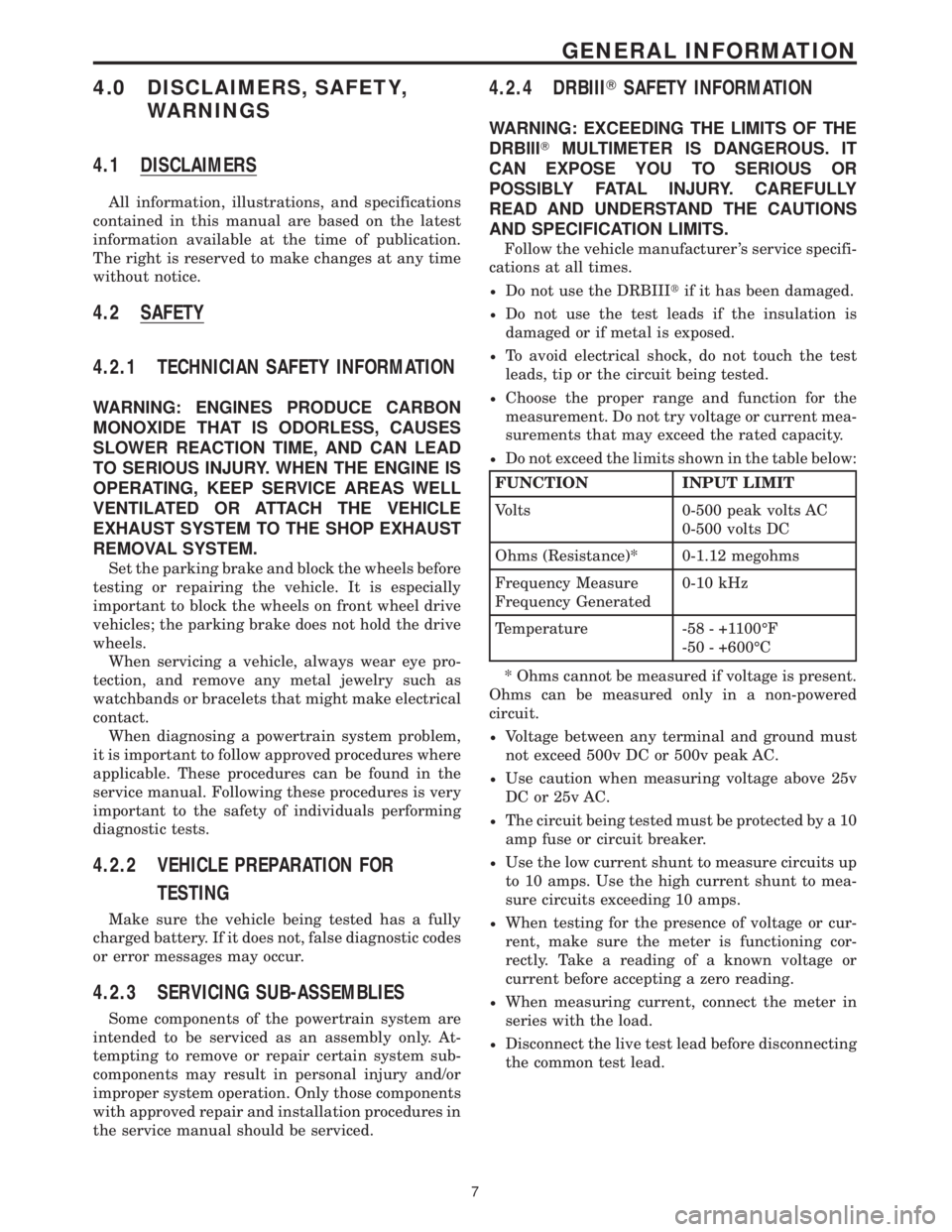
4.0 DISCLAIMERS, SAFETY,
WARNINGS
4.1 DISCLAIMERS
All information, illustrations, and specifications
contained in this manual are based on the latest
information available at the time of publication.
The right is reserved to make changes at any time
without notice.
4.2 SAFETY
4.2.1 TECHNICIAN SAFETY INFORMATION
WARNING: ENGINES PRODUCE CARBON
MONOXIDE THAT IS ODORLESS, CAUSES
SLOWER REACTION TIME, AND CAN LEAD
TO SERIOUS INJURY. WHEN THE ENGINE IS
OPERATING, KEEP SERVICE AREAS WELL
VENTILATED OR ATTACH THE VEHICLE
EXHAUST SYSTEM TO THE SHOP EXHAUST
REMOVAL SYSTEM.
Set the parking brake and block the wheels before
testing or repairing the vehicle. It is especially
important to block the wheels on front wheel drive
vehicles; the parking brake does not hold the drive
wheels.
When servicing a vehicle, always wear eye pro-
tection, and remove any metal jewelry such as
watchbands or bracelets that might make electrical
contact.
When diagnosing a powertrain system problem,
it is important to follow approved procedures where
applicable. These procedures can be found in the
service manual. Following these procedures is very
important to the safety of individuals performing
diagnostic tests.
4.2.2 VEHICLE PREPARATION FOR
TESTING
Make sure the vehicle being tested has a fully
charged battery. If it does not, false diagnostic codes
or error messages may occur.
4.2.3 SERVICING SUB-ASSEMBLIES
Some components of the powertrain system are
intended to be serviced as an assembly only. At-
tempting to remove or repair certain system sub-
components may result in personal injury and/or
improper system operation. Only those components
with approved repair and installation procedures in
the service manual should be serviced.
4.2.4 DRBIIITSAFETY INFORMATION
WARNING: EXCEEDING THE LIMITS OF THE
DRBIIITMULTIMETER IS DANGEROUS. IT
CAN EXPOSE YOU TO SERIOUS OR
POSSIBLY FATAL INJURY. CAREFULLY
READ AND UNDERSTAND THE CAUTIONS
AND SPECIFICATION LIMITS.
Follow the vehicle manufacturer 's service specifi-
cations at all times.
²Do not use the DRBIIItif it has been damaged.
²Do not use the test leads if the insulation is
damaged or if metal is exposed.
²To avoid electrical shock, do not touch the test
leads, tip or the circuit being tested.
²Choose the proper range and function for the
measurement. Do not try voltage or current mea-
surements that may exceed the rated capacity.
²Do not exceed the limits shown in the table below:
FUNCTION INPUT LIMIT
Volts 0-500 peak volts AC
0-500 volts DC
Ohms (Resistance)* 0-1.12 megohms
Frequency Measure
Frequency Generated0-10 kHz
Temperature -58 - +1100ÉF
-50 - +600ÉC
* Ohms cannot be measured if voltage is present.
Ohms can be measured only in a non-powered
circuit.
²Voltage between any terminal and ground must
not exceed 500v DC or 500v peak AC.
²Use caution when measuring voltage above 25v
DC or 25v AC.
²The circuit being tested must be protected by a 10
amp fuse or circuit breaker.
²Use the low current shunt to measure circuits up
to 10 amps. Use the high current shunt to mea-
sure circuits exceeding 10 amps.
²When testing for the presence of voltage or cur-
rent, make sure the meter is functioning cor-
rectly. Take a reading of a known voltage or
current before accepting a zero reading.
²When measuring current, connect the meter in
series with the load.
²Disconnect the live test lead before disconnecting
the common test lead.
7
GENERAL INFORMATION
Page 1227 of 4284
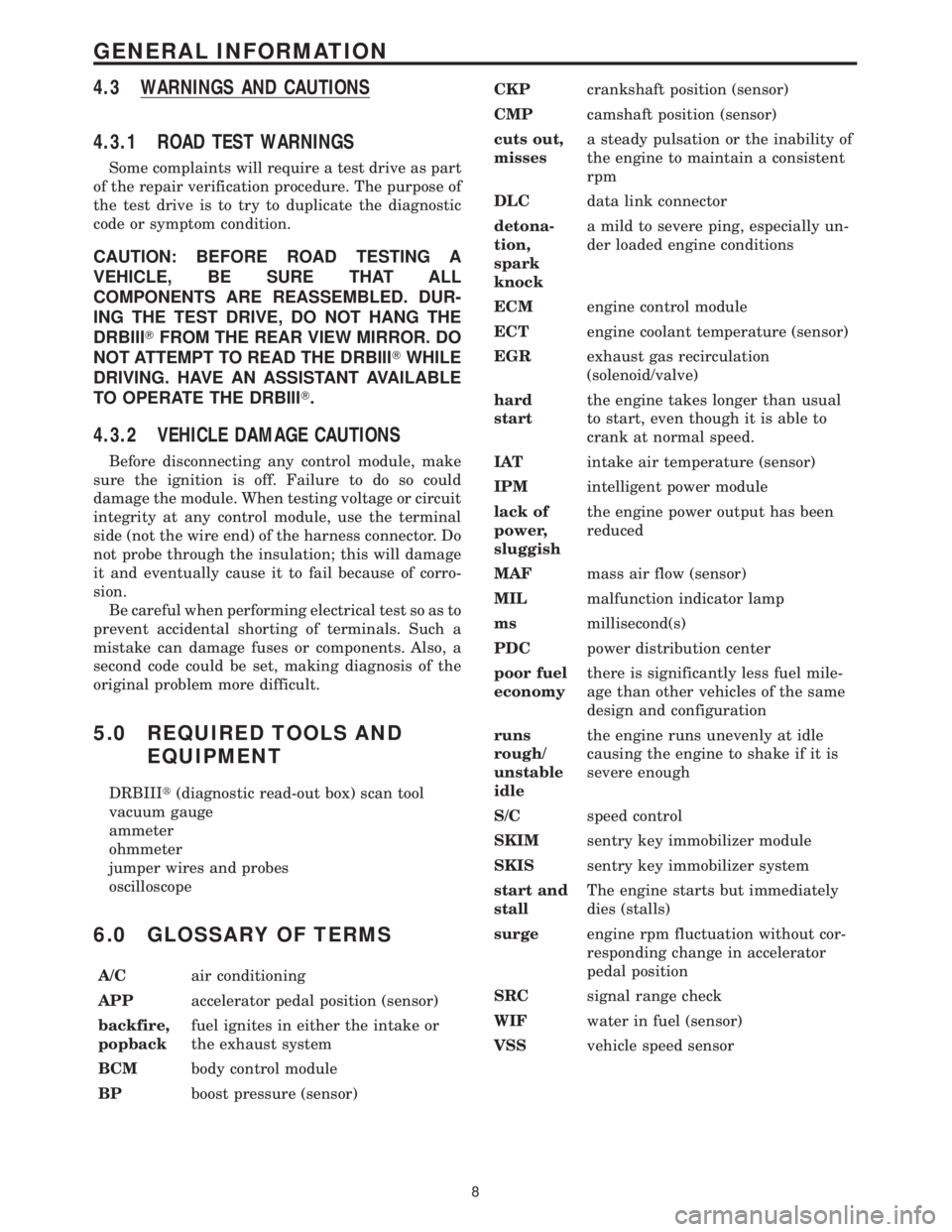
4.3 WARNINGS AND CAUTIONS
4.3.1 ROAD TEST WARNINGS
Some complaints will require a test drive as part
of the repair verification procedure. The purpose of
the test drive is to try to duplicate the diagnostic
code or symptom condition.
CAUTION: BEFORE ROAD TESTING A
VEHICLE, BE SURE THAT ALL
COMPONENTS ARE REASSEMBLED. DUR-
ING THE TEST DRIVE, DO NOT HANG THE
DRBIIITFROM THE REAR VIEW MIRROR. DO
NOT ATTEMPT TO READ THE DRBIIITWHILE
DRIVING. HAVE AN ASSISTANT AVAILABLE
TO OPERATE THE DRBIIIT.
4.3.2 VEHICLE DAMAGE CAUTIONS
Before disconnecting any control module, make
sure the ignition is off. Failure to do so could
damage the module. When testing voltage or circuit
integrity at any control module, use the terminal
side (not the wire end) of the harness connector. Do
not probe through the insulation; this will damage
it and eventually cause it to fail because of corro-
sion.
Be careful when performing electrical test so as to
prevent accidental shorting of terminals. Such a
mistake can damage fuses or components. Also, a
second code could be set, making diagnosis of the
original problem more difficult.
5.0 REQUIRED TOOLS AND
EQUIPMENT
DRBIIIt(diagnostic read-out box) scan tool
vacuum gauge
ammeter
ohmmeter
jumper wires and probes
oscilloscope
6.0 GLOSSARY OF TERMS
A/Cair conditioning
APPaccelerator pedal position (sensor)
backfire,
popbackfuel ignites in either the intake or
the exhaust system
BCMbody control module
BPboost pressure (sensor)CKPcrankshaft position (sensor)
CMPcamshaft position (sensor)
cuts out,
missesa steady pulsation or the inability of
the engine to maintain a consistent
rpm
DLCdata link connector
detona-
tion,
spark
knocka mild to severe ping, especially un-
der loaded engine conditions
ECMengine control module
ECTengine coolant temperature (sensor)
EGRexhaust gas recirculation
(solenoid/valve)
hard
startthe engine takes longer than usual
to start, even though it is able to
crank at normal speed.
IATintake air temperature (sensor)
IPMintelligent power module
lack of
power,
sluggishthe engine power output has been
reduced
MAFmass air flow (sensor)
MILmalfunction indicator lamp
msmillisecond(s)
PDCpower distribution center
poor fuel
economythere is significantly less fuel mile-
age than other vehicles of the same
design and configuration
runs
rough/
unstable
idlethe engine runs unevenly at idle
causing the engine to shake if it is
severe enough
S/Cspeed control
SKIMsentry key immobilizer module
SKISsentry key immobilizer system
start and
stallThe engine starts but immediately
dies (stalls)
surgeengine rpm fluctuation without cor-
responding change in accelerator
pedal position
SRCsignal range check
WIFwater in fuel (sensor)
VSSvehicle speed sensor
8
GENERAL INFORMATION
Page 1229 of 4284
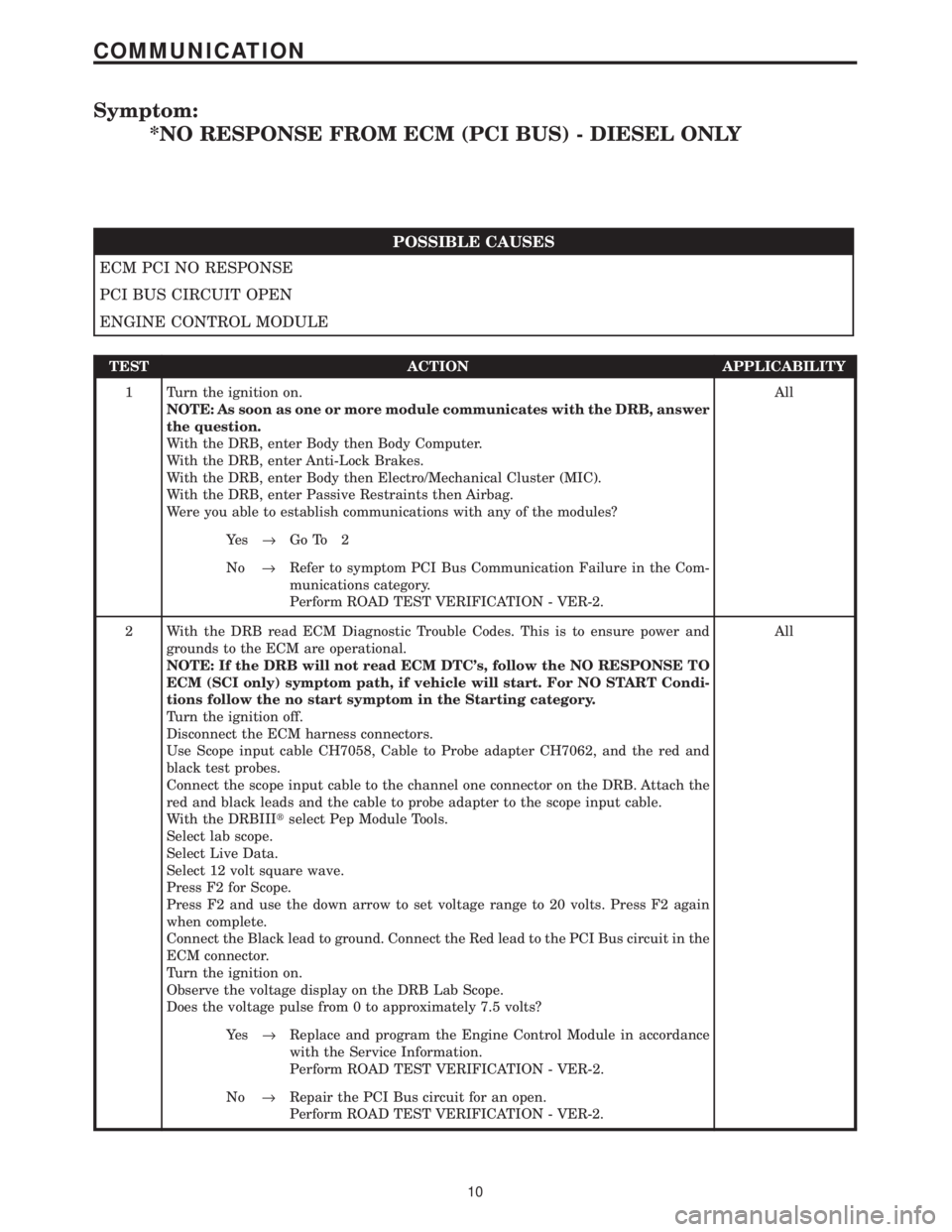
Symptom:
*NO RESPONSE FROM ECM (PCI BUS) - DIESEL ONLY
POSSIBLE CAUSES
ECM PCI NO RESPONSE
PCI BUS CIRCUIT OPEN
ENGINE CONTROL MODULE
TEST ACTION APPLICABILITY
1 Turn the ignition on.
NOTE: As soon as one or more module communicates with the DRB, answer
the question.
With the DRB, enter Body then Body Computer.
With the DRB, enter Anti-Lock Brakes.
With the DRB, enter Body then Electro/Mechanical Cluster (MIC).
With the DRB, enter Passive Restraints then Airbag.
Were you able to establish communications with any of the modules?All
Ye s®Go To 2
No®Refer to symptom PCI Bus Communication Failure in the Com-
munications category.
Perform ROAD TEST VERIFICATION - VER-2.
2 With the DRB read ECM Diagnostic Trouble Codes. This is to ensure power and
grounds to the ECM are operational.
NOTE: If the DRB will not read ECM DTC's, follow the NO RESPONSE TO
ECM (SCI only) symptom path, if vehicle will start. For NO START Condi-
tions follow the no start symptom in the Starting category.
Turn the ignition off.
Disconnect the ECM harness connectors.
Use Scope input cable CH7058, Cable to Probe adapter CH7062, and the red and
black test probes.
Connect the scope input cable to the channel one connector on the DRB. Attach the
red and black leads and the cable to probe adapter to the scope input cable.
With the DRBIIItselect Pep Module Tools.
Select lab scope.
Select Live Data.
Select 12 volt square wave.
Press F2 for Scope.
Press F2 and use the down arrow to set voltage range to 20 volts. Press F2 again
when complete.
Connect the Black lead to ground. Connect the Red lead to the PCI Bus circuit in the
ECM connector.
Turn the ignition on.
Observe the voltage display on the DRB Lab Scope.
Does the voltage pulse from 0 to approximately 7.5 volts?All
Ye s®Replace and program the Engine Control Module in accordance
with the Service Information.
Perform ROAD TEST VERIFICATION - VER-2.
No®Repair the PCI Bus circuit for an open.
Perform ROAD TEST VERIFICATION - VER-2.
10
COMMUNICATION